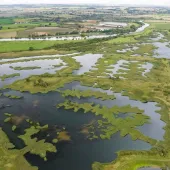Restoration of Sandy Heath Quarry

First published in the May 2015 issue of Quarry Management as Collaborative Restoration
Across the UK, Lafarge Tarmac have developed a unique approach to the restoration and rehabilitation of quarries. At Sandy Heath in Bedfordshire, the company has collaborated with a number of partners to restore the land and create a space that can be enjoyed by both locals and visitors
Operational since the mid-1950s, Sandy Heath Quarry is an 85ha site that comprises active workings, rehabilitated areas and permitted but unworked areas. Together with their partners – including the Royal Society for the Protection of Birds (RSPB), the local quarry liaison group, Central Bedfordshire Council, and the Bedfordshire, Cambridgeshire & Northamptonshire Wildlife Trust – Lafarge Tarmac have been working to rehabilitate the quarry and restore the land to create a thriving ecosystem and destination for visitors.
Background to the project
At the turn of the 18th century, Sandy Heath was a vibrant ecosystem that supported woodland and plant communities that were dominated by dwarf ericaceous shrubs or ‘heathland’ and acid grassland. Since then these natural plant communities have contracted due to agricultural intensification, commercial conifer forestry and the extension of settlements. The areas of habitat that remain are fragmented and isolated, making them less attractive for wildlife and vulnerable to further degradation.
From the outset of this project, Lafarge Tarmac’s rehabilitation of the area has been centred on a desire to help create extensive tracts of acidic grassland and heathland that would contribute towards Bedfordshire’s Biodiversity Action Plan (BAP) targets, which include the aim to provide suitable habitat for the recolonization of key species of birds, including nightjars, woodlarks, linnets and whitethroats. In addition, due to the dramatic decline of acid grassland and heathland over the past 50 years, the restoration of such land is a key priority within the European Union.
Peter Bradley, the RSPB’s senior site manager for Bedfordshire and Hertfordshire, explained: ‘We recognize the great potential that mineral sites represent for recreating fast-disappearing national priority habitats. Sites such as Sandy Heath, when they are restored in the right way, can afford vital support for wildlife and offer superb natural environments for local communities to visit at their leisure.’
Making headway
Lafarge Tarmac started the rehabilitation of the completed eastern workings in the 1990s, after more than 30 years of mineral extraction. To begin with, the company placed restoration materials, such as sand, against the margins of the worked-out areas and introduced a grading system to achieve the required landform, which comprised slopes of varying gradients and orientations.
Richard Millican, Lafarge Tarmac’s restoration manager for the south of England, commented: ‘We added additional features through the creation of gullies that constantly reform through the action of wind and water. This provides loose sand and sunny vertical faces as well as undulating valley floors or ‘drumlins’ which will develop heather and lichens as the project matures. The placement of stone mounds and cascaded stone slopes has also created habitats for invertebrates and lichens, which complements the retention of exposed sand cliffs.’
Following this work, Lafarge Tarmac together with the RSPB reintroduced grazing to the restored areas using a rare breed of sheep – the four-horned Manx Loaghtan – to help maintain the acid grassland and heathland. By introducing grazing livestock, Lafarge Tarmac were able to control the establishment of weed species. Since 2012, this grazing pressure has been provided by rabbits.
Keeping up the pace
Over the course of this project, Lafarge Tarmac have worked closely with their partners, highlighting the importance of a collaborative approach to rehabilitation. Lafarge Tarmac and the RSPB manage the project with mandatory reviews every year and ad hoc meetings as and when required. On a practical level, Lafarge Tarmac are on hand to support the RSPB’s seeding and management of the area while facilitating the work of both contractors and volunteers at the site.
Progress on the project has been significant. In addition to developing heathland and acid grassland plant communities, the rehabilitated areas have already become home to rare lichens, liverworts and moss species. Dwarf ericaceous species have established their presence and are producing seeds. Fifty species of birds have been recorded using the site; of these, more than 25 species are known to breed within the site.
A survey undertaken in 2009 found that in excess of 10% of the recorded invertebrate species at the site are rare or scarce within Britain and 32 species of beetles were new to Bedfordshire. The site is also particularly important for its solitary bees and wasps – indeed, the first British record of one species of spider-hunting wasp was made at Sandy Heath.
Moving forward
In the long term, Lafarge Tarmac and the RSPB aim to provide public access to the Sandy Heath site, as it is adjacent to the national headquarters of the charity and its flagship nature reserve, The Lodge.
The RSPB has also taken a Farm Business Tenancy on an adjacent freehold area to grow ‘wildlife-friendly’ crops which will provide food for threatened farmland birds and nectar for invertebrates.
Over the coming years, as the work progresses, small pools and wetland are likely to develop, providing additional biodiversity resources for wet ericaceous habitat. This will target species such as the natterjack toad due to the invertebrate interest of the site being very high.
Richard Millican commented: ‘We are proud of our work with the RSPB in helping to create this environment which both people and wildlife can enjoy. We will be continuing to work with the RSPB as, due to the high value of the site for invertebrates, we believe that it could be declared a regional wildlife site and could potentially hold a national wildlife designation.’
- Subscribe to Quarry Management, the monthly journal for the mineral products industry, to read articles before they appear on Agg-Net.com








